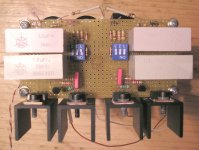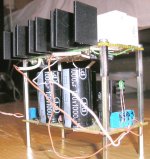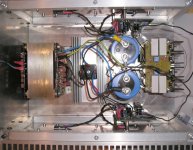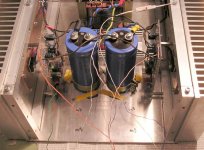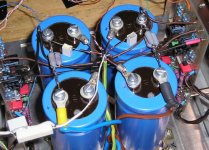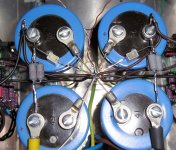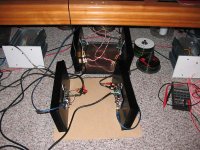Aleph L finished  (it's done on the older version of AL schematic)
(it's done on the older version of AL schematic)
Measurments showed:
(btw - there isn't pot at the output right now but 10k resistor from out+ to GND)
Output PSU voltage: 53,1V (secondaries were only 1x50V)
- drop on R111:
L ch: 0,633V
R ch: 0,637V
- drop on Q103:
L ch: 4,2V
R ch: 4,2V
- drop on R107:
L ch: 4,2V
R ch: 4,2V
- drop on common Drain to GND: 33V
Hmm - all other measurment are pretty close to original schematic - excpet the last one - considering +53V PSU voltage - I would more expect something like 27V ...
Btw - the fets have around 45-50°C surface temperature - too much or not to worry about?
There are two changes to original schematic - one is lower PSU voltage and other one value of c104 - instead of 680pF 1000pF ...
Measurments showed:
(btw - there isn't pot at the output right now but 10k resistor from out+ to GND)
Output PSU voltage: 53,1V (secondaries were only 1x50V)
- drop on R111:
L ch: 0,633V
R ch: 0,637V
- drop on Q103:
L ch: 4,2V
R ch: 4,2V
- drop on R107:
L ch: 4,2V
R ch: 4,2V
- drop on common Drain to GND: 33V
Hmm - all other measurment are pretty close to original schematic - excpet the last one - considering +53V PSU voltage - I would more expect something like 27V ...
Btw - the fets have around 45-50°C surface temperature - too much or not to worry about?
There are two changes to original schematic - one is lower PSU voltage and other one value of c104 - instead of 680pF 1000pF ...
Attachments
Hi Chip,
thanks again for this explanation ...
Btw - about those source resistors measurments - I was refering to this post by wuffwaff
That can be found here:
http://www.diyaudio.com/forums/showthread.php?s=&threadid=43890&perpage=10&highlight=&pagenumber=3
thanks again for this explanation ...
Btw - about those source resistors measurments - I was refering to this post by wuffwaff
Hi Kirc,
2.1A with 50% ac-current-gain should give around 50 watts 8 ohm (voltage limited) and 35 watts 4 ohm (current limited). (4.2A peak current)
25 watts 4 ohms means only 3.5A paek current or 1-2.1/3.5 = 40% ac-current-gain
To get 90 watts 4 ohms (if you want that) you must raise peak current to 6.7A. With 2.1A bias this means around 68% ac-current gain. .
To get this you must lower R21 until 68% of the ac current flow through the upper source resistors and 32% through the lower source resistors (at 10 watt 8 ohms for example)
Try something like 390 ohms for R21.
William
That can be found here:
http://www.diyaudio.com/forums/showthread.php?s=&threadid=43890&perpage=10&highlight=&pagenumber=3
It will get a bit crowded at the back of the chassis ...
Trannie is "classical": EI; 120VA/2x12V + 40VA/2x25V
At around 1,35-1,4A bias/channel it works perfectly, doesn't produce hum, hasn't got any temp rises that would be worth to mention, etc ... With few words: EXCELLENT TRANNIE!!!
So now I'm not worried for bigger brother - A30 - for which I intend to use 2 pcs 160VA trannies from same manufacturer ...
I must still find a way to mount attenuator and selector switch somehow somewhere there at the back ...
Ofcourse - gretz bridge will NOT have his own heatsink but will be mounted directly to bottom ... So I will get some more place for capacitors placement and all ...
I'm still thinkig of a possibillitiy to use 4 of them instead od 2 - but then it will be REALLY crowdy
Trannie is "classical": EI; 120VA/2x12V + 40VA/2x25V
At around 1,35-1,4A bias/channel it works perfectly, doesn't produce hum, hasn't got any temp rises that would be worth to mention, etc ... With few words: EXCELLENT TRANNIE!!!
So now I'm not worried for bigger brother - A30 - for which I intend to use 2 pcs 160VA trannies from same manufacturer ...
I must still find a way to mount attenuator and selector switch somehow somewhere there at the back ...
Ofcourse - gretz bridge will NOT have his own heatsink but will be mounted directly to bottom ... So I will get some more place for capacitors placement and all ...
I'm still thinkig of a possibillitiy to use 4 of them instead od 2 - but then it will be REALLY crowdy
Attachments
It worked and played but annoying buzz was there - and I've tried many different GND connections versions - but no significant succes ...
So obviously it was AC ripple ...
So I added another pair of capacitors + 0R16 resistance and so formed CRC filter ... (I will try to lower down resistance to somewhere around 0R1 - cause now I have almost 0,5V drop ... - but I haven't got enough resistors at hand right now)
AND it works without hum )))))
)))))
So obviously it was AC ripple ...
So I added another pair of capacitors + 0R16 resistance and so formed CRC filter ... (I will try to lower down resistance to somewhere around 0R1 - cause now I have almost 0,5V drop ... - but I haven't got enough resistors at hand right now)
AND it works without hum
Attachments
BUT  now I have a bit higher bias current flowing through power resistor in "lower" half (between Source of the mosfet and -V) - on the "upper" one I can measure around 0,490V and on the "lower" one 0,536V (resisitors are 0R33) ... (same for both channels) ...
now I have a bit higher bias current flowing through power resistor in "lower" half (between Source of the mosfet and -V) - on the "upper" one I can measure around 0,490V and on the "lower" one 0,536V (resisitors are 0R33) ... (same for both channels) ...
The voltage on PSU caps is same for (+) and (-) and completely simetrical ...
Also measured Voltage drop between (+V) and sense vs voltage from sense to (-V) differs for around 0,16V ... Before it was completely identical ...
What does that mean? Why suddenly thid change?
I also find DC offset a bit higher than before - before it was like 40 and 50mV - now it is like 60 and 70mV ...
The voltage on PSU caps is same for (+) and (-) and completely simetrical ...
Also measured Voltage drop between (+V) and sense vs voltage from sense to (-V) differs for around 0,16V ... Before it was completely identical ...
What does that mean? Why suddenly thid change?
I also find DC offset a bit higher than before - before it was like 40 and 50mV - now it is like 60 and 70mV ...
Attachments
Hehe ... "problem" solved 
The thing was - because of hard acces to some parts of circuitry - I measured the voltage between one side of the resistor and -V on PSU capacitor - and after trying a bit harder I've manage to measure the votlage drop on both sides of the resistor after all - and YEP - now everything is OK )))
)))
BUT then again - now I'm not quite satisfied while I have quite some voltage drop on the power supply cabling itself ... And hence that difference ...
Well, it's fun to giving a birth to that little chap ))
))
Btw - it sings very nice Altough my ears says (but not mesaured yet) it starts to degrade the highs with raising the volume ... I guess I'll have to fidle a little with AC current gain a bit ... (that was allready in my plan before listening session) ...
Altough my ears says (but not mesaured yet) it starts to degrade the highs with raising the volume ... I guess I'll have to fidle a little with AC current gain a bit ... (that was allready in my plan before listening session) ...
The thing was - because of hard acces to some parts of circuitry - I measured the voltage between one side of the resistor and -V on PSU capacitor - and after trying a bit harder I've manage to measure the votlage drop on both sides of the resistor after all - and YEP - now everything is OK
BUT then again - now I'm not quite satisfied while I have quite some voltage drop on the power supply cabling itself ... And hence that difference ...
Well, it's fun to giving a birth to that little chap
Btw - it sings very nice
Banned
Joined 2002
Banned
Joined 2002
Banned
Joined 2002
jleaman said:Heck no.. Running 4 mini a's at full 1amp bias 1 stereo block per speaker connected bi-amp. Worknig great.. Of course they are still connected to the test speakers incase soemthign does happen
Mine operates at 1,5A bias and around 13,5-15V rails under load ... (this 1,5V volts of difference are the result of our house 230V is indeed very strictly within +/-10% - but unfortunately that also means during the day it "jumps" from around 210V to 250V
Well, I'll allready "switched" from test speakers to more serious ones - but still - I know perfectly what you mean ...
I still have some strange startups from time to time - when the amp gets full -V at speakers outputs
In normal circumstances that is not the case - but I'm still not sure is it possible to get such possibly speaker damaging spike at some rare occasions (like AC 230V cut off for a moment - that's something that's quite "often" in our town)
Banned
Joined 2002
Yeah, I do use a termistor - but in particullary case when there is AC short term (0.xy sec) "shut down" - which is quite often in our neighbourhood  --> termistor doesn't help much - it's still warm enough to have almost 0 resistance - so it isn't doing it's function
--> termistor doesn't help much - it's still warm enough to have almost 0 resistance - so it isn't doing it's function  ((
((
As said - I really don't get it what is the problem - same PCB - just used as a A5 - no problems at all ... This one - in majority works OK - but again and adain during test phase - from time time at powering on - it "sucks" the speaker membrane in and it stays there for few seconds (I guess it would - since I switch it off instantly) ...
As said - I really don't get it what is the problem - same PCB - just used as a A5 - no problems at all ... This one - in majority works OK - but again and adain during test phase - from time time at powering on - it "sucks" the speaker membrane in and it stays there for few seconds (I guess it would - since I switch it off instantly) ...
- Status
- This old topic is closed. If you want to reopen this topic, contact a moderator using the "Report Post" button.
- Home
- Amplifiers
- Pass Labs
- 1 channel of MiniA working - measurments
